Banking queens involve keeping queens in individual cages by themselves and storing them in close proximity to each other.
They are stored inside a normal hive with young bees who can keep the queens well-fed and warm until they are needed by the beekeeper.
We have banked queens since 2021 and learned a few things about how to keep queens in a bank. We will mainly bank queens to keep them ready and available for customers who need to buy a queen to save a colony or increase their apiary size through making splits.
Queen banks are not normal for backyard beekeepers to have and are typically only used by commercial beekeepers or those distributing queen bees to others.
Banking queens can be a high-risk endeavor as it means you are placing many queen cages inside a colony that may completely disregard the queens inside of them. We will regularly have several thousand dollars worth of queens in a single queen bank.
Table of Contents
Why Do Beekeepers Bank Queens

A beekeeper may bank queens for several reasons, but it is essentially a way to save mated queens for later purposes. Sometimes beekeepers will buy multiple or hundreds of queens at a time, and they are not able to place them in their new colony right away.
Queens can be banked all year long based on when the beekeeper needs them. Or they are a commercial beekeeper raising queens and need to store their queens until they are ready to ship out.
This is also a common reason to bank queens as it’s better to bank a mated queen then to dedicate a mating nuc to an already proven queen.
Complications In Queen Banking
A colony will typically only have one laying queen, and every beginner beekeeper course will teach you that queens will want to kill each other. This is very true and is an example of what can cause a lot of problems in a queen bank.
In a queen bank, you are placing multiple caged queens in a colony full of worker bees who do not know these queens. All the queens are eager to get out and start laying eggs, but they cannot. In the meantime, they are communicating with the other queens and basically saying, “I will kill you” over and over. But they can’t, so it’s more like two dogs barking on either side of the fence.
But while these queens are giving each other the “what for,” they still need to be kept warm, fed, and taken care of. This is the job of the regular honey bees in the colony, the worker bees that are confused about the multiple or hundreds of queens in their colony.
In their confusion, you need the worker bees to take care of all these queens equally. If they don’t, the queens will die in their cages from neglect. A honey bee wants to be loyal to a single queen, so you have to be careful when introducing a lot of queens to a colony.
If another queen in the colony is laying eggs or one of the caged queens gets out, the worker bees will abandon the caged queens, and they will all die.
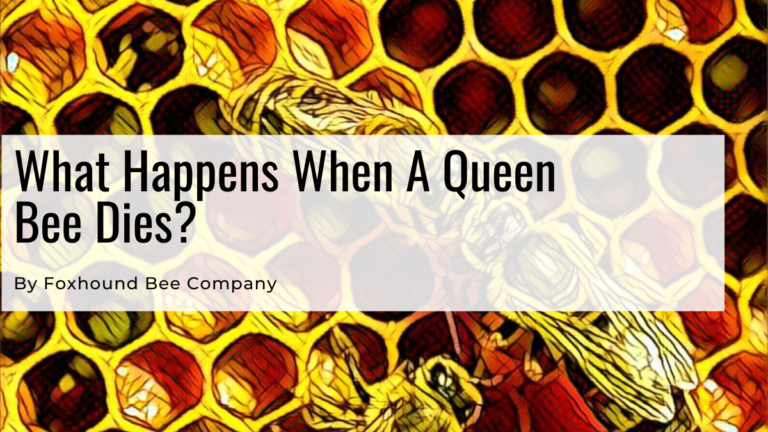
What Happens When A Queen Bee Dies?
When a queen bee dies inside a colony, it can be difficult for the colony. While the queen bee isn’t the leader of a colony,
Our Queen Banking Setup
We will keep our queen bank in our working bee yard right next to our retail store. We do this so the queens can easily be pulled for customers, and since we work mostly with hobby and backyard beekeepers, it needs to be easy to pull one or two mated queens quickly.
It is possible to keep a queen bank in several different ways. Just like any other part of beekeeping, beekeepers have their personal preference in how to bank queens.
We have opted to use a single or double brood box that has a queenless colony in it. We only keep our queen banks running through several weeks in the spring and early summer.
It is possible to keep a queen bank through the winter, but it is not something that we do. Long-term banking or indoor banking is more complicated and could require some advanced techniques.
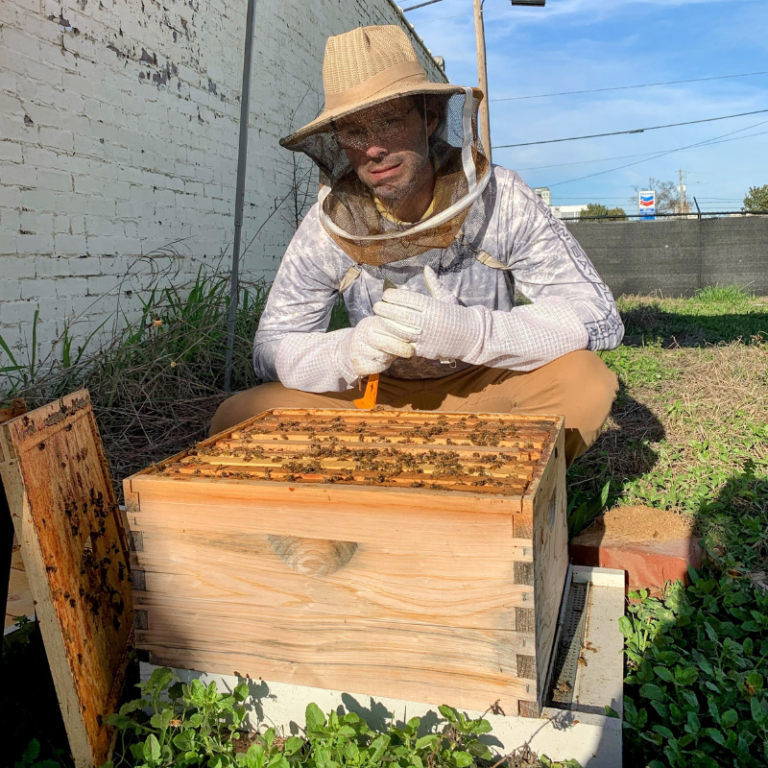
Queen Banking Success
We have really enjoyed having banked queens, and our customers do as well. We will regularly bring in hundreds of queens from multiple queen breeders around the US and will pre-sell and hold queen bees in our bank.
This has been a great way to serve our customers as sometimes you really just need a queen, and it’s hard to find one. Because we have a brick-and-mortar store, our customers can just walk in and get a queen from us. It’s been a great way to get a variety of queen genetics into our local area, and that is a great option for long-term breeding.
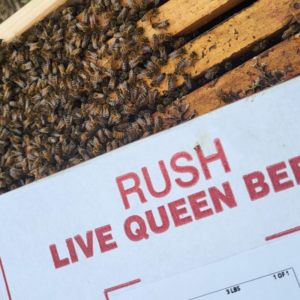
Queen Banking Failures
Fortunately, we have been able to avoid the catastrophic failures where dozens of queens are killed, costing us hundreds or thousands of dollars. What has caused us the most trouble is the summer heat. We have found that a colony full of bees and queen cages may have trouble regulating its internal temperature.
The mass of bees and the lack of mobility of the queens on the banking frame can create an overheating situation in the colony. There are ways to mitigate this by shading the colony, providing water, and using insulated hives. So this is likely something we can solve, but that has been our largest issue so far.
Queen Banking Tools
There are a lot of tools that can be used in queen banking, and most of them are pretty standard. Queen excluders, double screen boards/Snelgrove boards, feeders, protein patties, varroa treatments, record-keeping tools, etc… are all very helpful. And most beekeepers are already using them. But there are some unique tools. Project Apis M has a lot of really great information on queen banking techniques.
Queen Banking Frames
The great part of queen banking is that it doesn’t necessarily require much-specialized equipment. The piece of equipment that is most unique is the queen banking frame, which is a custom, often DIY frame that is designed to hold queen cages. The queen banking frame you use is based on the type of queen cages you use.
We have only run a queen bank using JZBZ queen cages, and we modified frames to hold the JZBZ shipping bars in them. It is very similar to a grafting frame used by beekeepers, but it holds the shipping bar.
The shipping bar keeps honey bees from getting to the fondant or candy plug in the queen cage, so there is no concern about the bees releasing the queen early.
A California Mini cage can fit into a JZBZ Cell bar. So you can use the same banking frame for both JZBZ and California Minis.
Queen Cages
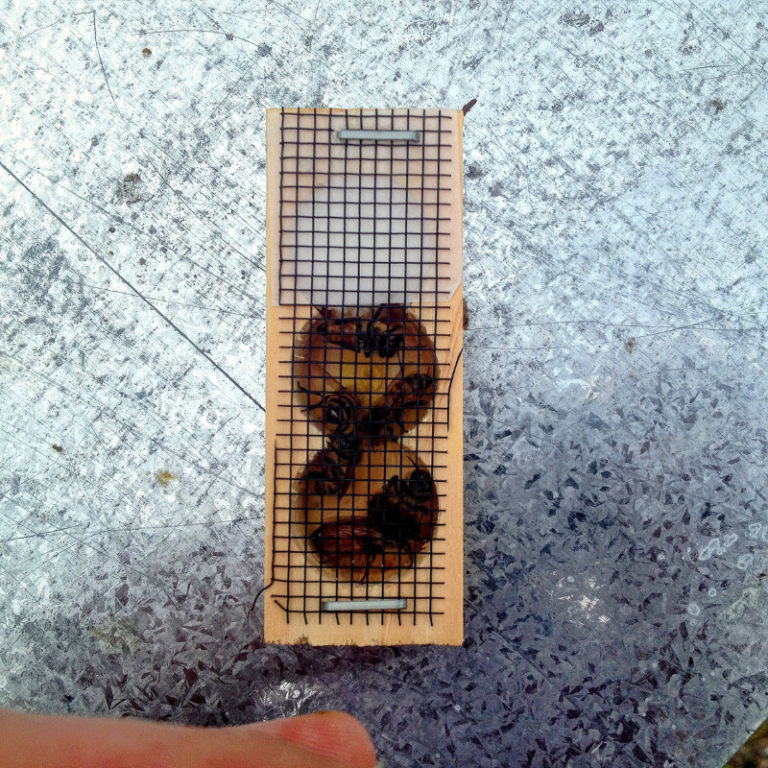
Not all queen cages are made the same, and some of them are better for queen banking than others. We really prefer the JZBZ queen cages for many reasons, and one of those is that they work great for banking. These are the 3 most common queen cages.
California Mini Queen Cage: A small wooden cage with a wire mesh, often used for banking due to its compact size that allows for efficient use of space.
JZs BZs Queen Cage: A plastic cage with ample ventilation, designed for easy handling and transportation of queens, commonly used for both banking and shipping.
Three-Hole Wooden Queen Cage: This traditional wooden cage has three holes, which can be plugged with candy or cork, allowing for controlled release of the queen when banking.
Queen Banking Options
As I mentioned earlier, there are several options on how to bank queens, and the strategy you use is based on the situation and how many queens you are banking. It’s possible to use multiple queen bank frames in the same bank.
The fundamentals of queen banking demand you have a strong colony with plenty of carbohydrates from honey or sugar, protein from pollen or a substitute, and bees to take care of the queens.
The best bees for feeding queens are young nurse bees. A colony full of old, hungry forager bees won’t tend to the queens well. It also has to be without a laying queen as well, at least where the queen cannot access the bank.
All Queen Banks Need
Healthy colony free of stress and disease
6+ frames of adult bees, with at least half being young, nurse bees
2+frames of capped, sealed brood
Honey or sugar water
Pollen or pollen substitute
A steady supply of hatching brood
Running a Queenless Queen Bank
A queenless bank is the simplest option for banking queens and can either be done in a single box or 2 boxes. You will want the hive to be full of workers, especially young workers who can immediately start taking care of the caged queens.
Generally, the more queens you are banking, the more nurse bees, food, and resources they will need. It’s possibly bank several hundred queens in one hive, but they will just need extra resources. A good, compact queen bank with plenty of resources will have better success than a 2 box queen bank with sparse resources.
Prepare the Queenless Queen Bank
Before adding the caged queens, removing any laying queens from the colony is important. Removing her completely is better than caging her in the bank. Removing the queen for 15 minutes before adding the banking frame is sufficient. You can remove her for 24 hours, but longer than that is not advised.
The banking frame is placed directly in the middle of the brood nest with a frame of sealed brood on either side of it. The hatching bees will soon turn into nurse bees and quickly tend to the caged queen.
It’s important to check any of the frames of open brood for the development of queen cells. The last thing you want is for a queen to hatch out naturally and take over the queen bank.
Running a Queenright Queen Bank
A queenright colony is more complicated and isn’t for every situation. The best way to image a queen right bank is a queenless bank on top of a queen right bank.
The greatest advantage to a queenright bank is the donor frames of brood are directly under the queen bank that needs them.
Another advantage of a queen right bank is the warmth from the colony, which can keep the queen bank warm. A huge bonus is keeping the bank in a cold environment.
Preparing the Queenright Queen Bank
As I mentioned, the queen-right box is underneath the queenless queen bank. If the laying queen gets into the queen bank, she or her workers will kill the caged queens.
So she will need to be kept separate using a queen excluder or a double-screened board.
The queen right box on the bottom of the colony should be fully functioning, healthy, and with plenty of resources. The queenless box with a queen bank should be set up, as I mentioned above.
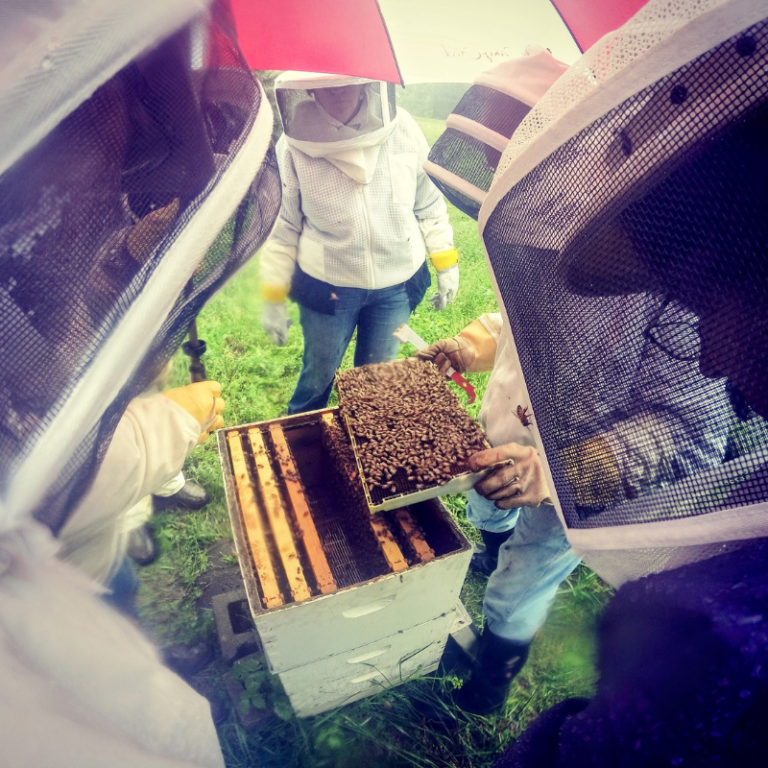
Queen Pheromones in a Queenright Bank

Queen pheromones are passed mostly through touch from queen to honey bee worker to worker. As long as all bees are able to touch each other, there is a risk enough that if this pheromone is present, the nurse bees will abandon the caged queens. Because of this, it is good to have more of a barrier between the 2 boxes.
This can either be done with a medium box with new frames separating the two boxes. The worker bees are able to pass through the bottom queen right box, through the queen excluder, past the medium box, and into the queen bank.
The double-screened board is two screens that the bees cannot pass through, nor can they touch each other through it. So if this is placed between a queen right box and the queenless queen bank, the bees cannot move from one box to the other.
Maintaining a Queen Bank
A queen bank is only as successful as the resources it has. A healthy colony free from varroa and diseases that are well stocked with protein, carbohydrates, and nurse bees will care for its caged queens well. As days pass, without a steady supply of hatching bees, the amount of nurse bees will diminish.
This is why the best way to maintain a queen bank is through the introduction of frames of sealed brood. This can be done weekly with the addition of 1 or 2 frames rotated in and 1 or 2 frames rotated out.
As these frames of brood are added, it’s wise to keep checking for developing queen cells. Removing them as they are found.
Tricks for Increasing Success
Keep queens in the bank that are roughly the same age. You don’t want year 2 queens mixed with year 1 queens.
Provide a steady supply of syrup for the queen bank.
Give nurse bees full access to queen cages so they can tend the queens easily.
Inspect cages for dead queens so you can course correct if necessary.
As you remove queens, remove them from the outside edges of the banking frame.
Bank queens without honey bee attendants in the cage with the queen.
If banking two frames, place them beside each other.
Remove a frame from the box to allow nurse bees easy access to cages.
Colony strength is paramount, don’t take it for granted.
A good supply of syrup will boost the odds of success.
FIFO: First In, First Out on queens.
FAQ On Queen Banking
What exactly is queen banking in beekeeping?
Queen banking is a beekeeping technique where surplus queens are stored temporarily in a special hive setup called a queen bank until they are needed for colony expansion or replacement.
How long can you safely bank a queen bee?
Queens can usually be banked for several weeks. However, for optimal health and vitality, it’s best to limit banking to the shortest time necessary. In specific situations, queens can be banked for months.
What are the ideal conditions for a queen banking colony?
The ideal conditions include a strong host colony with plenty of young nurse bees, stable temperatures, sufficient food stores, and good ventilation.
How do you ensure banked queens stay healthy?
Regular monitoring, proper nutrition, disease control, and ensuring the queens are well attended by worker bees are key to maintaining the health of banked queens.
Is there a limit to how many queens can be banked in one colony?
Yes, the limit depends on the size of the honey bee population and their ability to adequately care for the banked queens without causing stress. Up to several hundred can be banked in one hive.
How do you introduce a banked queen to a new hive?
Introduce a banked queen by placing her cage between the frames in the new hive, allowing the worker bees to gradually accept her by eating through a candy plug.
What is the success rate of queen banking?
The success rate can be very high if managed properly, with most banked queens successfully introduced to new hives. However, success rates can vary based on several factors, including duration of banking and colony conditions of new hive.
What do you feed banked queens?
Banked queens are fed by the nurse bees, which are fed by the sugar syrup or honey and protein/pollen in their hive.
How do you mark queens in a banking system for identification?
Queens can be marked with a small dot of non-toxic, queen-safe paint on their thorax, which can also be color-coded by year according to international standards. The queen marking procedure is the same as an unbanked queen.
How can a beginner beekeeper get started with queen banking?
Start with learning the basics of honey bee biology and queen care, then proceed with setting up a strong host colony and acquiring the necessary equipment for queen banking. It is possible to only bank a couple of queens by placing them on top bars near the brood nest.
What's the difference between queen banking and queen rearing?
Queen rearing is the process of breeding new queens, while queen banking is the practice of storing those queens after they have been reared and until they are needed.
Can you bank queens that have already started laying eggs?
Most queens that are being banked are laying queens and not virgin queens. But it is possible to bank virgin queens and even queen cups that hatch into queen cells.



